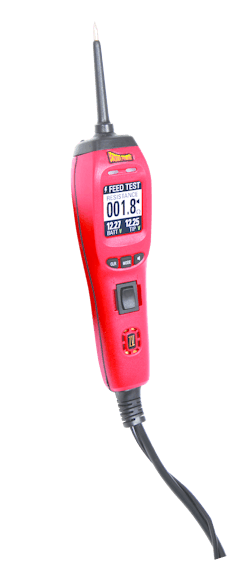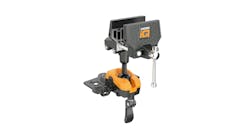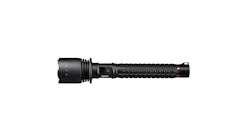The Power Probe IV activates components with battery power and ground for quick functional testing. The large, bright color-LCD screen allows for easy visibility for eight diagnostic testing modes. The Power Probe IV includes a 23' cable for greater reach and accessibility. Users can test the resistance of circuits in ohms, quickly read AC/DC and battery source voltage for instant voltage drop testing and easily identify the health of a fuel injector and circuit with one simple back probe. The Power Probe IV also supplies computer-safe voltage for testing PCM/ECM drivers.
The review
Phil Fournier, owner of Phil’s Auto Clinic in Hemet, Calif., liked the Power Probe III. However, he says the newer Power Probe IV is a big improvement to the former model, and it is easier to operate.
“The Power Probe III was great, but this is a much more powerful and accurate tool. It is a full-featured voltmeter and does significantly more than you can do with a voltmeter, in a very user-friendly fashion,” Fournier says. “The added features of frequency, AC voltage peak to peak readings, injector pulse width, feed voltage, inductive kick and volt drop make it the ideal tool for testing a no-start.”
“The basic functions of the tool are simple to use, and even the more advanced functions are not hard to learn if one uses the manual,” he adds.
The included manual is well written and easy to follow, according to Fournier. But he adds that some electronics features need to be understood prior to reading the manual.
The Power Probe IV comes ready to use in a sturdy plastic case, which Fournier says could be slightly larger to allow the tool to be stored with the tip on. The Power Probe IV comes with clips for connecting the tool directly to the battery. The ECT 2000 transmitter – which when used in conjunction with the Power Probe IV, can help find open circuits in wiring – is available separately.
“I like the backlit screen and the fact that the voltmeter now reads to hundredths of a volt,” Fournier says, noting the Power Probe III could not, which limited its use as an accurate test meter.
“I like the new features of reading frequency, injector pulse width, peak-to-peak voltages and so forth,” he says. “It is a great tool for checking a no-start out in the parking lot when you don’t want to make multiple trips back to the shop for tools.”
He adds that the new test for volt drop, which shows the difference between battery voltage and voltage at the tip, is a great learning tool for techs to understand the concept.
As a possible improvement, Fournier suggests adding a true scope with the ability to adjust time base and amplitude. “As a dedicated scope user, I would prefer to see a pattern many times over a digital interpretation of the pattern,” he says.
Because he has several lab scopes, Fournier says he will continue to use a variety of tools to diagnose vehicles. However, he says the Power Probe IV is the first tool he goes to for electrical diagnostics, particularly when testing power window components.
“In the old days, when power windows were simple, we used the old design Power Probe effectively. Now that we have electronics and networks involved, we can use this new Power Probe to check for voltage, frequency and duty cycle on the network wire going to the door or seat module quickly and simply, as well as the power and ground circuits that we always used it on before,” Fournier says.
Beyond power windows, Fournier says the Power Probe IV saves time when checking output devices such as canister purge solenoids, cooling fans, transmission solenoids and more.
“It is a very useful tool with multiple uses, making it the first thing we grab for electrical issues, including no-starts,” Fournier says.


